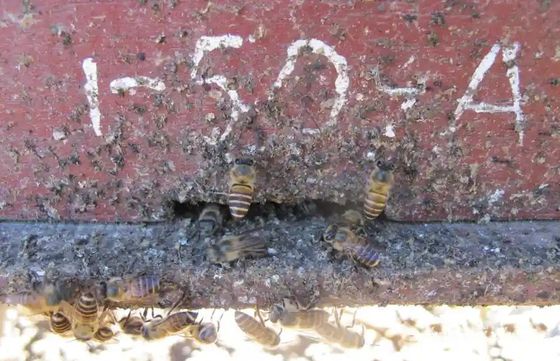Bees found to protect themselves from wasps by applying 'animal droppings' around their nests

by
It is known that honeybees with high information processing ability can teach the acquired skills to other individuals and recognize the concept of numbers in connection with symbols . The threat to such honeybees is a group of hornets that are relatively large and highly aggressive, but a new study has revealed that honeybees protect themselves from hornets by applying animal droppings around their nests. Wasp.
Honey bees (Apis cerana) use animal feces as a tool to defend colonies against group attack by giant hornets (Vespa soror)
https://journals.plos.org/plosone/article?id=10.1371/journal.pone.0242668
Bees Witnessed Using Tools in Nature For The First Time ... And It's Really Gross
https://www.sciencealert.com/scientists-discover-the-first-tool-and-non-plant-weapon-used-by-honeybees-poo
Honey bees use animal poo to repel giant hornet attacks | Bees | The Guardian
https://www.theguardian.com/environment/2020/dec/09/honey-bees-use-animal-poo-to-repel-giant-hornet-attacks

The research was triggered by the sighting of strange brownish spots near the entrance to the hive when Canadian researchers visited a Vietnamese beekeeper. When a researcher asked the beekeeper what the spots were, the beekeeper replied that it was ''buffalo droppings' collected by Apis cerana.' Researchers who learned that Apis cerana collects livestock feces and applies it to the hive have decided to cooperate with Vietnamese researchers to proceed with the investigation.
First, the research team surveyed 72 Vietnamese beekeepers, and 63 answered that 'there are spots made of animal droppings near the entrance to the hive.' All the beekeepers who answered that the nest box was painted with animal dung were raising honeybees, and the five beekeepers who kept only Apis mellifera (Apis cerana) all had dung in the nest box. He answered that it was not painted.

Many beekeepers interviewed by the research team argued that Apis cerana smeared animal dung on its hives in response to wasps attacking their nests. When the research team actually observed the hive of Apis
Vespa soror is a closely related species of the giant hornet that inhabits India, Thailand, Vietnam and southern China, and is a threat to the giant hornet that inhabits this area. Several wasps, including the Vespa soror, attack bee nests, killing thousands of bees and bringing larvae back to their nests in just a few hours, and sometimes hijacking their nests.

by Rushen
In the graph below, the vertical axis represents the number of animal droppings painted on the hive, and the horizontal axis represents time. Comparing the solid line 'Vespa soror attacked birdhouse' and the dashed line 'Vespa soror unattacked birdhouse', the birdhouses attacked by Vespa soror consistently dung. You can see that is being painted. The number of dung lumps painted on the hive remained high for some time after the Vespa soror attack ended.

Also, when the research team placed an extract from the Vespa soror near the entrance to the nest, the Apis cerana began to smear animal droppings on the hive, similar to when attacked by the actual Vespa soror. Apis cerana applied not only buffalo feces to the hive, but also feces excreted by birds and other mammals, and some of them were piled up near the entrance instead of being applied to the hive. He said that he sometimes did. In addition, when attacked by Vespa velutina (hornet), which is smaller than Vespa soror and has low aggression, the behavior of smearing feces on the hive was hardly observed.

by Heather R Mattila / Plos One
The graph below shows the results measured by the research team on the effect of actually applying feces to the birdhouse. Light gray indicates 'when almost no feces are applied', dark gray indicates 'when medium feces are applied', and black indicates 'when a large amount of feces is applied'. It shows how often Vespa soror visited the nest, how often Vespa soror landed on the nest, how often Vespa soror landed at the entrance to the nest, and how often Vespa soror tried to destroy the entrance to the nest. I will. In any case, you can see that Vespa soror's attack is reduced if the nest is smeared with moderate or large amounts of dung. Nests with moderate or higher dung were 77-81% less likely to land at the entrance and 94% less likely to bite into the nests than those without.

According to the research team, the behavior of Apis cerana to apply animal droppings to their nests has been reported not only throughout Vietnam, but also in China, Thailand, Bhutan, and Nepal. It's unclear why animal droppings can repel Vespa soror, but the chemicals in the droppings can deter attacks and disrupt the markings that indicate the nests that Vespa soror targets. The research team thinks there is.
Also, the behavior observed this time, 'Apis cerana collects animal dung and applies it to the hive to repel foreign enemies,' may be the first example of wild Apis cerana 'using tools.' There is no such thing. There are various opinions about the use of tools, but the behavior of Apis cerana is necessary for the use of tools that 'collect, hold, manipulate objects from the outside, and apply them in a different way from their original reason for existence.' Heather Matilla, a professor of the research team, said that it meets the above factors.

by Heather R Mattila / Plos One
Related Posts:







